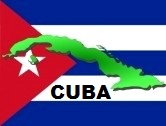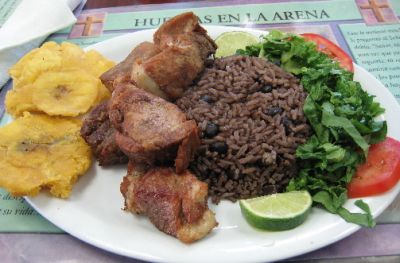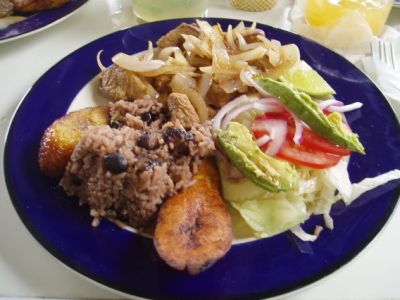


| Congris | Fried Plantains | Roast Pork | Ropa Vieja | Rice Pudding |
| Cuban cuisine is a fusion of Spanish, African and Caribbean cuisines. Cuban recipes share spices and techniques with Spanish and African cooking, with some Caribbean influence in spice and flavor. This results in a unique, interesting and flavorful blend of the several different cultural influences. A small, but noteworthy, Chinese influence can also be accounted for, mainly in the Havana area. During colonial times, Cuba was an important port for trade, and many Spaniards who lived there brought their culinary traditions along with them. As a result of the colonization of Cuba by Spain, one of the main influences on the cuisine is from Spain. Along with Spain, other culinary influences include Africa, from the Africans that were brought to Cuba as slaves, and Dutch, from the French colonists that came to Cuba from Haiti. Another important factor is that Cuba itself is an island, making seafood something that greatly influences Cuban cuisine. Another contributing factor to Cuban cuisine is the fact that Cuba is in a tropical climate. The tropical climate produces fruits and root vegetables that are used in Cuban dishes and meals |  |
 |
Although Western Cuba's cooking is technically criollo as well (as this term signifies the existence of Spanish roots), its style can be separated from mainstream criollo, particularly in Havana. This city, for a number of reasons, was more continental and closer to the European cuisine[citation needed]. There's also a notable Chinese influence, in dishes such as sopa china (an egg and onion soup) and arroz salteado (sauteed rice), among others. Rice is usually consumed separately from beans, and flour is much more commonly used (it is almost completely ignored in mainstream criollo cooking). Some Havana dishes make frequent use of alcaparrado, a mix of olives, raisins and caper which provide the sweet-and-sour-inspired flavor that is typical of this cuisine. Alcaparrado is used as an ingredient in several recipes, usually as part of sauces to accompany meats. It is also cooked together with ground beef to provide the meat stuffing for a variety of Cuban pastries, or finger food, very popular with Cubans. |
| Other common finger foods and dishes of Havana are pastelitos (puff pastry filled with fruit pulps (especially guava) or ground beef), croquetas (small cylinders of paste, made with a heavy bechamel sauce and ground beef, ham, chicken, fish, or cheese, covered with breadcrumbs and deep fried), papas rellenas (fried potato balls filled with ground beef), picadillo ā la Habanera (ground beef with alcaparrado, served with white rice, black beans and fried plantains) and niņos envueltos (beef filled with alcaparrado and served in pepper sauce). |
| Other Spanish dishes can be found in Cuba, such as the paella, arroz con pollo (chicken cooked with yellow rice much like a paella), and the empanada gallega (which is similar to an English meat pie). Due to heavy Galician and Asturian migration during the early 20th century, many northern Spanish dishes made their way to Cuba and influenced the cooking of many families, like the pulpo ā la gallega. |
| Fish dishes are also common, especially in coastal areas, and although Cuba has a well-developed lobster fishing industry, it is used very sparsely. Aside from Cuba's present economic condition, which makes lobster an unreachable food for most families, Cuban cuisine was always of inland origin, therefore fish and sea products are as commonly used as in coastal areas, where crab is another common food staple. Popular fish recipes are enchilado (shrimp, fish, crab or lobster in a sauce that, despite its name, contains no chili), and ā la vizcaína, a tomato-based sauce of Basque origin used to cook bacalao (salted cod). |
| Home | Next |